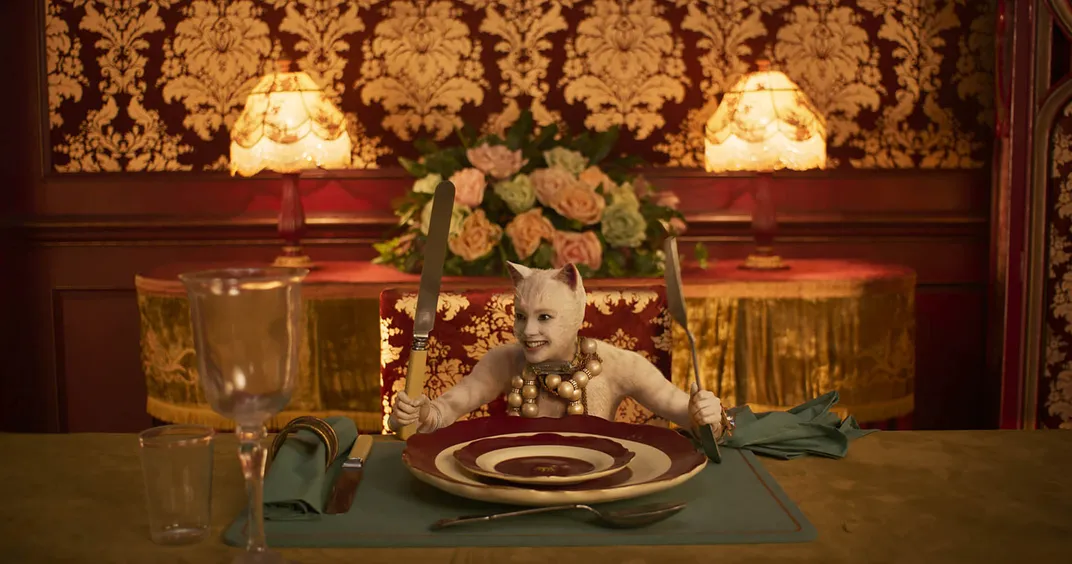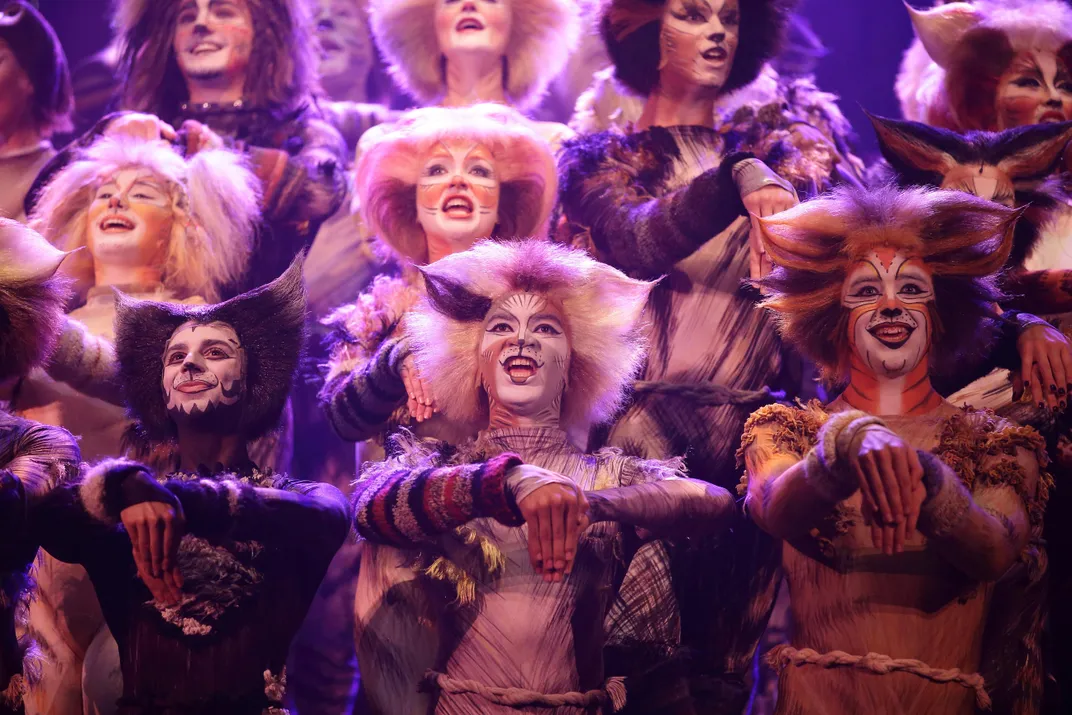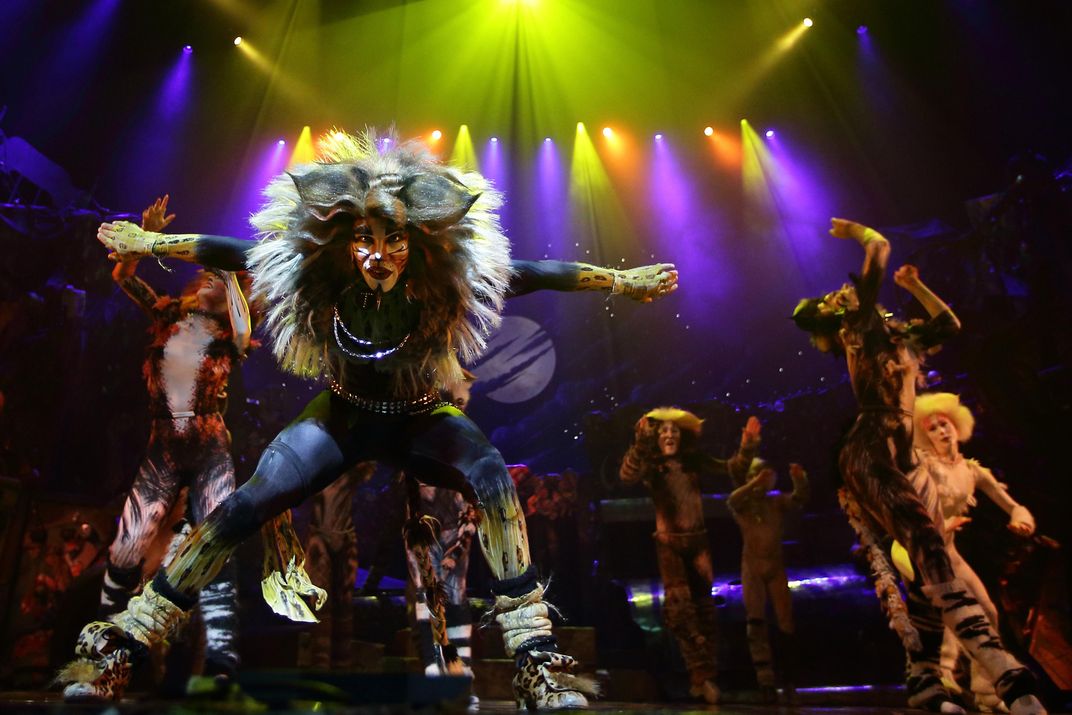Purrfect or A-Paw-Ling? Why ‘Cats’ Still Gives Some Theatergoers Paws
Experts disagree on the hit musical’s merits; four of the original production’s slinky, feline costumes are held by the Smithsonian
/https://tf-cmsv2-smithsonianmag-media.s3.amazonaws.com/filer/e4/b4/e4b488ca-c8df-43f6-b86c-e0a7502fae0f/cats-gallery-2-1900x1000-5d30e53937482-1.jpg)
Cats: Why? It’s a question that has long split musical theater devotees, and when Universal premiered a preview of its upcoming movie revival of Cats earlier this year, viewers had questions. Why did so many top-tier stars (think Ian McKellen, Taylor Swift and Judi Dench) sign on for a project that is so heavily marked by computer-generated imagery that it turned them into bizarre-looking, nude-yet-furry felines? Why turn a show so many people have already seen into a film at all? And why did Andrew Lloyd Webber decide to turn an 80-year-old T.S. Eliot book into a musical in the first place?
Doubts about Cats predate the musical, which debuted in London in 1981 and on Broadway in 1982. But when musical theater historian John Kenrick experienced the show’s first moments in New York’s Winter Garden theater during opening week, he suddenly understood the hype.
“We’d never seen anything quite like it,” he says. Cats emerged from every corner, transforming the space into an alley that seethed with feline life. “Performers were literally dancing on the armrests and coming in and out of the floor, the ceiling,” he says. “It blew our minds as an audience.”

Those first shows were the beginning of a worldwide love affair—and an international juggernaut. Cats was like nothing else in theater, but its origins weren’t brand-new. Rather, it had its beginnings as a decades-old volume of poetry published decades before.
Old Possum’s Book of Practical Cats, a slender 14-poem collection by T.S. Eliot, is held together by its fluffy subject matter: cats. The felines described have fanciful names like Mr. Mistoffelees and Gus, and are portrayed roaming London, having run-ins with police dogs and one another, and being as condescending and playful as the real things.
The story could have ended there, but in 1977 composer Andrew Lloyd Webber began turning it into a song cycle. At first, he staged the show at his private estate, but when Valerie Eliot, the wife of the late poet, heard the songs, she offered Webber some unpublished work to use if he wanted to expand it. And so he did, with historic results. Its 7,485-show original Broadway run is the fourth-longest in history, ahead of Les Misérables and A Chorus Line.

Four of the production’s punk rock-inspired costumes reside in the collections of the Smithsonian’s National Museum of American History. They’re the work of John Napier, a designer known for clothing everyone from Michael Jackson’s Captain EO and Siegfried and Roy to winning Tony Awards for the costumes of Les Misérables, Starlight Express and Sunset Boulevard. Napier also won a Tony for his Cats’ clothes. The form-fitting costumes turned dancers’ bodies into slinky, so-80s felines complete with over-the-top, 80s-era hair and legwarmers.
“They were designed to indicate a kind of street or punky look,” says Ryan Lintelman, the museum’s entertainment curator. Each of the costumes carved out a unique niche for the cat in question; for example, the actor portraying the magical “conjuring cat” Mr. Mistoffelees wore a catsuit outfitted with blinking lights that sparkled at a key moment in the show.

In the late 1970s, Lloyd Webber was a hot commodity thanks to hit musicals like Jesus Christ Superstar and Evita. But though the show came with great expectations, it was seen as a significant risk. “It was just a recipe for disaster,” Lloyd Webber later recalled. The material was considered too esoteric to carry an entire show, and nobody thought British performers could carry a dance-fueled musical.
Those worries were dispelled at the show’s London premiere. There, theatergoers marveled at Gillian Lynne-choreographed cats. Clad in dramatic, rock-inspired costumes, they slunk and pranced, posed and strutted. They also sang songs with Eliot’s lyrics. The premise was slender—each cat was trying to convince their paterfamilias, Old Deuteronomy, to choose them to go to cat heaven (the Heaviside Layer) and be reborn—but the sum was much greater than its parts.

Esoteric or not, it was the stuff of theater legend. The original London cast included theater greats Brian Blessed, Sarah Brightman and others. Since then, everyone from Betty Buckley to Leona Lewis has taken part in the Jellicle Ball. And while it became a show some loved to hate, Cats became one of the world’s longest-running shows.
Not to mention the music: “Memory,” the musical’s most famous song, has transcended to its own echelon of musical theater greatness. (Even if you haven’t seen the show, the tear-jerking ballad is likely quite familiar.)
The show is notoriously punishing; performers must be true triple-threats who can sing and act while performing challenging dance moves and embodying, well, cats. But its appeal never came down to a single performer, notes Kenrick. “There is no star of the show,” Kenrick says. Instead, the performance is episodic, featuring mostly single songs that feature the unique qualities of each cat character.
That lack of star power contributed to the show’s longevity. The music, costumes and production transcended any single performer. Today, the show is credited with helping create the mega-musical: a bombastic extravaganza that can last for years, even decades, and whose cast can be reinvented over time.
“The 1970s was kind of a fallow period in musical theater,” Lintelman notes. “Cats really emphasized spectacle in a way nothing had before.”
/https://tf-cmsv2-smithsonianmag-media.s3.amazonaws.com/filer/ab/0b/ab0b68ae-ff5e-45ca-8e74-fbeab75c8ce1/mistoffelees_nmah2004-01545.jpg)
The modern movie has done away with Napier’s costumes, opting instead for computer-generated imagery effects over stars’ unsettlingly naked-seeming human bodies. Will it do the source material justice—or just contribute to the longstanding controversy about whether the show is corny or a cornerstone of American popular culture?
If you don’t know whether to love or loathe Cats, rest easy—neither do the experts. The show leaves even Kenrick, a cat lover who named one of his feline companions Eliot, scratching his head. “I’ll be honest with you—the first half-hour was breathtaking. The last half-hour was fulfilling. But the almost two hours in the middle were another cat and another cat and another cat. Why?” Spectacle or no, the new film could purr—or leave viewers catatonic.
The costumes of Mr. Mistoffelees, Grizabella, Bombalurina and Rum Tum Tugger, held in the collections of the Smithsonian’s National Museum of American History, are currently not on view.
/https://tf-cmsv2-smithsonianmag-media.s3.amazonaws.com/accounts/headshot/erin.png)


/https://tf-cmsv2-smithsonianmag-media.s3.amazonaws.com/accounts/headshot/erin.png)